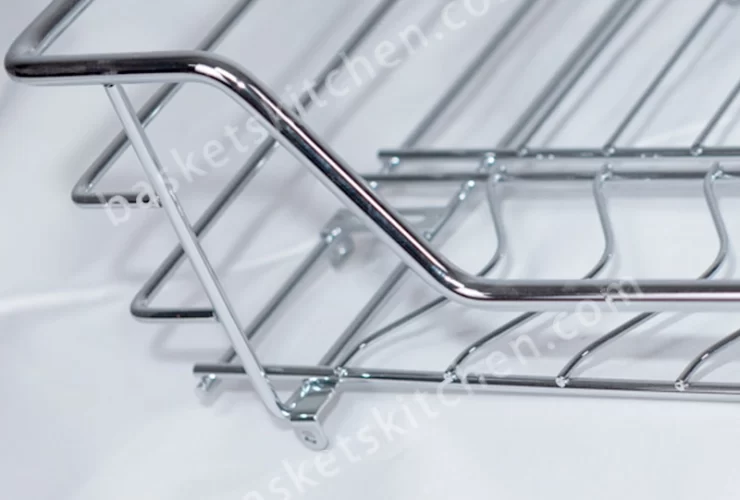Is a plastic or metal dish rack better?
When choosing between a plastic or metal dish rack, there are several factors to consider that can impact your decision, including durability, maintenance, aesthetics, and overall functionality. Here’s an in-depth look at the pros and cons of each option to help you determine which dish rack might be better suited to your needs.
Plastic Dish Racks
Pros:
- Affordability: Plastic dish racks are generally less expensive than their metal counterparts. This makes them a budget-friendly option for those looking to save money or who need a temporary solution.
- Lightweight: Plastic racks are lighter than metal racks, making them easier to handle, move, and store. This can be particularly useful in smaller kitchens where space is at a premium.
- Variety of Designs and Colors: Plastic dish racks come in a wide range of colors and designs, which can complement various kitchen aesthetics. Whether you prefer a bright, vibrant color or a more subdued, neutral tone, there’s likely a plastic rack that fits your style.
- Resistant to Rust and Corrosion: Unlike metal racks, plastic dish racks are not prone to rust or corrosion. This can be a significant advantage in environments with high humidity or in households where the dish rack is frequently exposed to water.
- Ease of Cleaning: Plastic dish racks are typically easy to clean. Most can be washed with soap and water, and they don’t require special maintenance to keep them looking good.
Cons:
- Durability Issues: While plastic dish racks are generally sturdy, they can be less durable over time compared to metal racks. Plastic can become brittle, crack, or warp, especially if exposed to high heat or heavy loads.
- Stains and Discoloration: Plastic can stain over time, particularly if it comes into contact with certain foods or beverages. Additionally, it can discolor with age, which might detract from its appearance.
- Limited Weight Capacity: Plastic racks typically have a lower weight capacity compared to metal racks. This means they may not be suitable for households with heavy dish loads or large pots and pans.
Metal Dish Racks
Pros:
- Durability and Strength: Metal dish racks, particularly those made from stainless steel, are known for their durability and strength. They can support heavier dishes, pots, and pans without bending or warping.
- Stylish Appearance: Metal racks often have a sleek, modern look that can enhance the aesthetic of a kitchen. Stainless steel, in particular, has a polished finish that complements contemporary decor.
- Heat Resistance: Metal racks are generally resistant to heat, making them suitable for placing hot pots and pans on them without the risk of warping.
- Long-Term Investment: Due to their durability, metal dish racks often represent a better long-term investment. With proper care, they can last for many years, reducing the need for frequent replacements.
Cons:
- Potential for Rust: While many metal dish racks are coated to prevent rust, cheaper or poorly coated racks can be susceptible to rusting, especially if they are not thoroughly dried after use.
- Heavier Weight: Metal dish racks are typically heavier than plastic ones. This can make them more cumbersome to move and may be a drawback in smaller or more compact kitchens.
- Maintenance: Metal dish racks require more maintenance to keep them in good condition. Regular cleaning is essential to prevent the buildup of water spots and potential rust, and some models may require occasional polishing to maintain their appearance.
- Cost: Metal dish racks are often more expensive than plastic ones. While this can be a worthwhile investment due to their durability, it’s a higher upfront cost compared to plastic alternatives.
Factors to Consider When Choosing
1. Budget: If you’re looking for a cost-effective solution, a plastic dish rack may be the better choice. However, if you’re willing to invest more for a longer-lasting product, a metal rack could be a better fit.
2. Kitchen Space: Consider the space available in your kitchen. If you have limited counter space, a lightweight plastic rack might be easier to handle. On the other hand, if you have ample space and need a heavy-duty solution, a metal rack could be ideal.
3. Aesthetics: Think about how the dish rack will fit with your kitchen decor. Plastic racks offer more color and design options, while metal racks provide a sleek and modern look.
4. Dish Load: Assess the typical amount and type of dishes you wash. For heavier loads and larger items, a metal rack with a higher weight capacity may be necessary. For lighter use, a plastic rack might suffice.
5. Maintenance Preferences: If you prefer a low-maintenance option, a plastic rack might be more suitable. If you don’t mind spending a bit of time on upkeep, a metal rack could offer greater durability and strength.
6. Environmental Impact: If environmental concerns are important to you, consider the lifecycle of the dish rack. Plastic racks can contribute to plastic waste, while metal racks, particularly those made from recycled materials, may be a more eco-friendly choice.
Conclusion
Both plastic and metal dish racks have their unique advantages and disadvantages. Plastic dish racks are often favored for their affordability, lightweight nature, and resistance to rust. However, they may lack the durability and stylish appeal of metal racks. Metal dish racks, on the other hand, offer greater strength, a sleek appearance, and long-term value, though they can be heavier and more expensive, and require more maintenance to prevent rust.
Ultimately, the choice between a plastic or metal dish rack depends on your specific needs, preferences, and budget. By carefully considering the factors discussed, you can make an informed decision that best suits your kitchen and lifestyle. Whether you opt for the practicality of plastic or the durability of metal, both types of dish racks can serve their purpose effectively, ensuring your dishes stay organized and your kitchen remains tidy.


